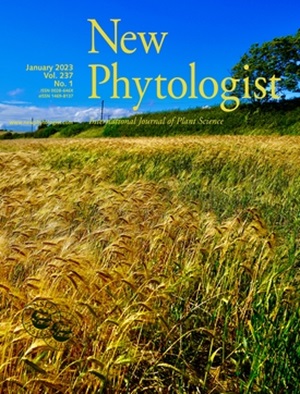Modulation of an evolutionarily conserved epigenetic regulon controlling abscisic acid catabolism enhances drought tolerance in wheat
IF 8.1
1区 生物学
Q1 PLANT SCIENCES
引用次数: 0
Abstract
- Drought stress significantly reduces crop yield by triggering abscisic acid (ABA) accumulation in plants. It involves the suppression of CYP707A genes, which encode enzymes that catalyze ABA. However, little is known about epigenetic control in the CYP707A gene-mediated drought stress response in wheat.
- In this study, we reported that TaCYP707A-6A/6B/6D but not TaCYP707A-5A/5B/5D participates in drought response in common wheat. Disruption of TaCYP707A-6B showed enhanced drought tolerance but also decreased fertility. Expression of TaCYP707A-6B is negatively associated with H3K27me3 level. An evolutionarily conserved CTCTGYTY motif cluster (binding site for a Jumonji H3K27me3 demethylase) was found in the intron of TaCYP707A-6B as well as the intron of CYP707A homologs in other plant species.
- Blocking the CTCTGYTY motif by dead Cas9 (dCas9) maintained a high level of H3K27me3 on the CYP707A gene, while decreasing its expression level leading to enhanced drought tolerance in both wheat and Arabidopsis. In particular, the mutant in which the intron bound by H3K27me3 demethylase was cut out without change of splicing pattern showed enhanced drought tolerance.
- Therefore, our study provides a novel approach to improve plant drought tolerance by manipulating an evolutionarily conserved cis-element bound by histone demethylases in the intron of CYP707A genes.
一个控制脱落酸分解代谢的进化保守表观遗传调控的调控增强了小麦的抗旱性。
干旱胁迫通过引发植物体内脱落酸(ABA)的积累而显著降低作物产量。它涉及CYP707A基因的抑制,该基因编码催化ABA的酶。然而,对CYP707A基因介导的小麦干旱胁迫反应的表观遗传调控知之甚少。在本研究中,我们报道了TaCYP707A-6A/6B/6D参与普通小麦的干旱响应,而TaCYP707A-5A/5B/5D不参与。破坏TaCYP707A-6B后,耐旱性增强,但生育力下降。TaCYP707A-6B的表达与H3K27me3水平呈负相关。在TaCYP707A-6B的内含子中发现了一个进化上保守的CTCTGYTY基序簇(一个Jumonji H3K27me3去甲基化酶的结合位点),在其他植物物种中也发现了CYP707A同源物的内含子。通过死亡Cas9 (dCas9)阻断CTCTGYTY基序,维持CYP707A基因上H3K27me3的高水平,同时降低其表达水平,从而增强小麦和拟南芥的耐旱性。特别是剪切H3K27me3去甲基酶结合的内含子而不改变剪接模式的突变体,其耐旱性增强。因此,我们的研究提供了一种新的方法,通过操纵CYP707A基因内含子中与组蛋白去甲基化酶结合的进化保守的顺式元件来提高植物的抗旱性。
本文章由计算机程序翻译,如有差异,请以英文原文为准。
求助全文
约1分钟内获得全文
求助全文
来源期刊

New Phytologist
生物-植物科学
自引率
5.30%
发文量
728
期刊介绍:
New Phytologist is an international electronic journal published 24 times a year. It is owned by the New Phytologist Foundation, a non-profit-making charitable organization dedicated to promoting plant science. The journal publishes excellent, novel, rigorous, and timely research and scholarship in plant science and its applications. The articles cover topics in five sections: Physiology & Development, Environment, Interaction, Evolution, and Transformative Plant Biotechnology. These sections encompass intracellular processes, global environmental change, and encourage cross-disciplinary approaches. The journal recognizes the use of techniques from molecular and cell biology, functional genomics, modeling, and system-based approaches in plant science. Abstracting and Indexing Information for New Phytologist includes Academic Search, AgBiotech News & Information, Agroforestry Abstracts, Biochemistry & Biophysics Citation Index, Botanical Pesticides, CAB Abstracts®, Environment Index, Global Health, and Plant Breeding Abstracts, and others.
 求助内容:
求助内容: 应助结果提醒方式:
应助结果提醒方式:


